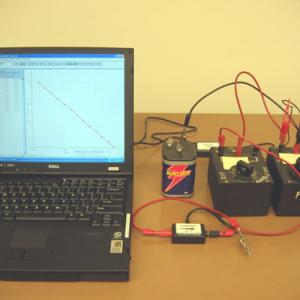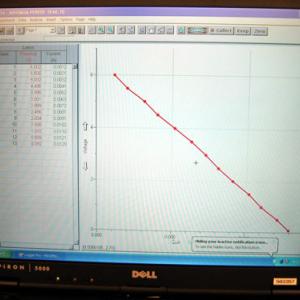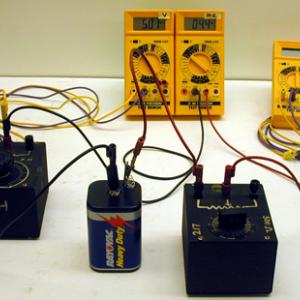College of Liberal Arts & Sciences
5E40.70 - Internal Resistance, Maximum Power and Impedance Matching
Place the battery, 500 Ohm pot, amp meter and 10000 Ohm pot all in series with the 500 Ohm pot set at 500 Ohms exactly. Place the volt meter across the junctions of the 10000 Ohm pot. Adjust the resistance of the 10000 Ohm pot until the battery output reads 6 volts. Plot the current and the voltage. Adjust the 10000 Ohm pot, so that the voltage reads 5.5 Volts. Again plot the current and voltage. Continue to do this in half volt steps down to 0.5 Volts. Computing the total power from the values that have been plotted should give a peak operating voltage curve. Hint: The output power should be at it's peak when the resistance of the 10000 Ohm pot is set at the same resistance as the sum of the 500 Ohm pot plus the internal resistance of the battery.
A volt and amp meter can be used in place of the voltage and current sensor with interface.
- Adam Niculescu, Peter Martin, "Making and Evaluating an Electrical Battery", TPT, Vol. 44, # 6, p. 343, Sept. 2006.
- James N. Boyd, "Power and Efficiency", TPT, Vol. 29, # 7, July 1991, p. 457.
- Jack A. Kaeck, "Power Transfer in Physical Systems", TPT, Vol. 28, # 3, March, 1990, p. 214.
- Mark A. Heald, "Maximum Power Transfer vs. Efficiency", TPT, Vol. 26, # 1, Jan. 1988, p. 10.
- J. Gerard Anderson, "Load Matching Mistake", TPT, Vol. 25, # 9, Dec. 1987, p. 546.
- L. V. Hmurcik and J. P. Micinilio, "Contrasts Between Maximum Power Transfer and Maximum Efficiency", TPT, Vol. 24, # 8, Nov. 1986, p. 492.
- Iain MacInnes, "Notes on the Condition for Maximum Power Transfer to the Load", TPT, Vol. 23, # 4, Apr. 1985, p. 224.
- Ellis D. Noll, "Determining the Internal Resistance of an Energy Source", TPT, Vol. 16, # 7, Oct. 1978, p. 478.
- David H. Current, "Combinatorial Rules for Batteries", AJP, Vol. 47, #5, May 1979, p. 463.
- Yaakov Kraftmakher, "1.7 Characteristics of a DC source", Experiments and Demonstrations in Physics, ISBN 981-256-602-3, p. 25.
Disclaimer: These demonstrations are provided only for illustrative use by persons affiliated with The University of Iowa and only under the direction of a trained instructor or physicist. The University of Iowa is not responsible for demonstrations performed by those using their own equipment or who choose to use this reference material for their own purpose. The demonstrations included here are within the public domain and can be found in materials contained in libraries, bookstores, and through electronic sources. Performing all or any portion of any of these demonstrations, with or without revisions not depicted here entails inherent risks. These risks include, without limitation, bodily injury (and possibly death), including risks to health that may be temporary or permanent and that may exacerbate a pre-existing medical condition; and property loss or damage. Anyone performing any part of these demonstrations, even with revisions, knowingly and voluntarily assumes all risks associated with them.




